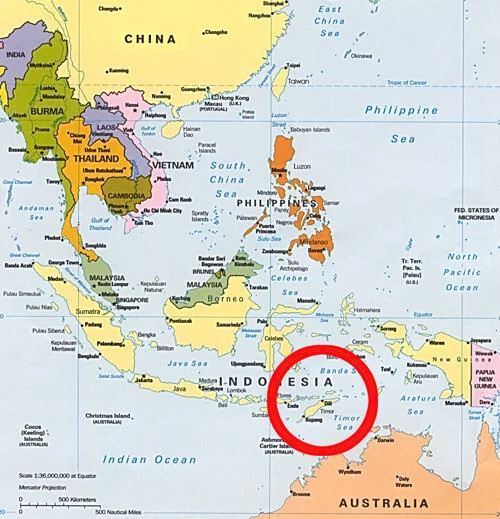Timor-Leste: One of the Least Visited Countries in the World
Location: South East Asia (Island Nation)
Capital: Dili
Dominant Religion: Catholicism
Currency: US dollar and East Timor centavo coins
Language: Tetun and Portuguese
Population: 1.6 million
Timor-Leste is a mountainous island surrounded by coral reefs teeming with marine life. Economically, East Timor relies on oil which was discovered in the 1970’s. From the air this place appears to be a tropical paradise. However, on the surface remains vivid memories of troubled waters.
Timor-Leste gained independence from Portugal in 1975 and then from Indonesia in 2002, making it one of the world’s youngest countries. This is a country that many western people have never heard of because of it’s youth. Nonetheless, it harbors a legacy of resistance unlike other places. For hundreds of years the Timorese fought for basic human rights regardless of what could be taken away from them.
Simplified History
Briefly touching on the important events that shaped the Timor-Leste you see today.
Remember there is so much more to this story…
The first Europeans to settle on this island were the Portuguese around 500 years ago. The Portuguese established a colony and fought for control over the island with the Dutch for centuries (the Dutch controlled most of modern day Indonesia).
The island was separated into halves; Dutch in the west and Portuguese in the east. The native Timorese revolted against colonial rule often during this era and were brutally suppressed; thousands were killed.
Timor-Leste was occupied by the Japanese during the Second World War. Japanese attempts to force the Timorese to grow food to support their troops was again met with great resistance. By the time the Japanese surrendered in 1945 more than 10% of the population had been murdered.
1975 - The Indonesian Invasion (loose interpretation)
The process of decolonization began in East Timor when the Portuguese Armed Forces overthrew the Caetano regime (Caetano was the Prime Minister of Portugal during this time). Political groups formed and entered into a coalition in hopes of achieving independence.
The new leaders claimed sovereignty regardless of Portugal’s refusal to recognize this. The political leaders continued to declare independence and established the Democratic Republic of East Timor. This is what is known as de facto government which is one that has seized power by force in spite of the government that legally maintains authority.
The Indonesian military bribed one of the party leaders to organize a coup in 1975. The invasion marked the beginning of what could be considered a genocide of the Timorese people.
When Indonesian forces invaded, it was the Timorese civilians that suffered greatly at the hands of the military. They were forced to watch their families raped, murdered and their bodies thrown into the sea. Their houses were burned and destroyed.
Many fled into the mountains but found little refuge there once they began bombing the mountainous areas.
The Timorese were rounded up into prison camps and many died of hunger. It is believed that half of the population was annihilated during the cleansing which could have lead to the ethnic, cultural and religious extinction of the Timorese people.
This brutal war continued from 1975 until the 1990’s.
My Thoughts
I knew virtually nothing about Timor-Leste before traveling here. I sat next to two wonderful people that live in Timor on the plane ride from Denpasar, Bali.
They were the ones that began to tell me about the history of Timor in hushed voices. The open wounds left behind from endless years of oppression are still fresh in people’s minds.
The people of Timor-Leste have been brutally exploited for hundreds of years. They carry wide smiles but sad eyes. I feel they have learned to cope with trauma differently than people in western countries.
For example, the man who checked me into my guest house in Dili casually told me he had just came from his brother’s funeral. He said this so nonchalantly that he could have been telling me about the weather. He was still friendly and wore a genuine smile, barely acknowledging my apology for his loss. The people here have thick skin in the presence of grief.
They seem to overlook the pain or bottle it up deep inside of themselves. I can only begin to imagine how these events have psychologically affected the people who live here.
Oppression ran rampant for the majority of this island’s history whether it was at the hands of the Portuguese, Dutch or Indonesians.
I was told that the people don’t hold grudges against Indonesian people; they don’t blame them for what happened throughout the 70’s, 80’s and 90’s. It’s the Indonesian military culture that the people of Timor-Leste will not so easily forgive. Despite everything that has happened here, the country is growing faster than most developing countries.
The Timorese are ready for change and are working hard to make it happen for themselves.
To learn more about Timor-Leste and how you can help this beautiful country thrive go to: https://www.care.org.au/country/timor-leste/
Here’s an alarming article describing sexual misconduct of UN staff in Timor:
Sources:
http://www.easttimorgovernment.com/history.htm
https://www.lonelyplanet.com/east-timor/history#304375
If you are interested in being deeply disturbed by a dialogue you will never forget, scroll to the end of this article: https://newint.org/features/1994/03/05/simply
*Disclaimer: Not Original Photos*







